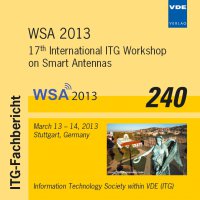Joint Spectrum Selection and Radio Resource Management for Distributed Antenna Systems with Cognitive Radio and Space Division Multiplexing
Konferenz: WSA 2013 - 17th International ITG Workshop on Smart Antennas
13.03.2013 - 14.03.2013 in Stuttgart, Deutschland
Tagungsband: WSA 2013
Seiten: 8Sprache: EnglischTyp: PDF
Persönliche VDE-Mitglieder erhalten auf diesen Artikel 10% Rabatt
Autoren:
Samano-Robles, Ramiro; Gameiro, Atilio (Instituto de Telecomunicaç˜ões, Campus Universitário, Aveiro, 3810-193, Portugal)
Inhalt:
Distributed antenna systems (DASs) and cognitive radio (CR) technology are expected to boost the performance of future wireless networks. However, opportunistic access to distributed spectrum resources with different network and economic characteristics requires new approaches for an appropriate spectrum and radio resource management (RRM). To partially fill this gap, this paper proposes a joint spectrum selection and RRM algorithm for the down-link of a DAS system assisted by CR. In this paper, each radio and spectrum resource is considered as a financial asset whose allocation has to be optimized based on economic metrics such as return and risk (variation of the return). The core of the RRM is based on an iterative weighted least squares (WLS) optimization where power levels and beamforming vectors are jointly calculated so as to comply with a different SINR (signal-to-interference-plus-noise ratio) for each scheduled user. This SINR level ensures the transmission of the selected modulation and coding scheme (MCS) with a given value of BLER (block error rate). The WLS scheme allows a smooth integration of scheduling and adaptive modulation and coding schemes with the underlying space division multiplexing layer. Each WLS iteration is solved by the method of gradient steepest descent, whose convergence speed is improved by reusing the outcome of previous WLS iterations. The weights of the WLS optimization contain network (queue length and fairness), as well as economic metrics (return and risk). This process is complemented by a multi-objective portfolio optimization for joint spectrum selection and radio resource allocation that aims to maximize return and reduce risk, where risk is found to be closely related to the interference created by secondary transmissions. It is shown that network and economic performance metrics can be both optimized given an appropriate trade-off between return and risk functions.


